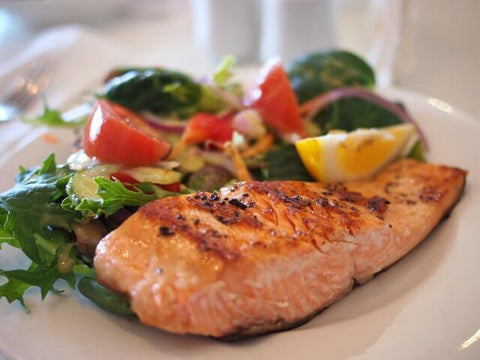
By Toni Sicola • September 8, 2019
Ladies, have you ever started a diet or exercise program with your male partner, only to notice that he loses weight and gets toned much more than you do?
If you've gone through this same experience when trying out the ketogenic diet, you're not the only one.
The difference between men and women when it comes to weight loss and muscle gain is common (and frustrating!). This is thanks to the hormonal differences between men and women.
In general, women are a lot more sensitive to diet and lifestyle changes. This is due to fluctuating hormones and the reproductive cycle.
A major change like the keto diet can create chaotic hormonal changes in women. This results in fatigue and exhaustion.
Some experience a more intense version of the "keto flu." Others experience thyroid issues since the thyroid needs glucose to create hormones.
With these things in mind, we've realized that women shouldn't approach the keto diet in the same way that men do.
Let's explore how women can safely and successfully put in place the keto diet. And how it might differ from the approach we see all over the web – one geared toward men.
What Is The Ketogenic Diet?
The ketogenic diet is a high-fat, moderate protein, low-carb way of eating. It encourages your body to burn fat instead of carbohydrates.
The diet puts you in a state of ketosis, which you can test for by dipping a keto test strip into your urine.
While the macronutrient ratios differ from person to person, here's what's most common:
- ➡️ 70% fats
- ➡️ 5% carbohydrates
- ➡️ 25% protein
Percentages can feel vague, but eyeballed serving sizes are helpful once you get the hang of it.
There are calculators online to help you determine your ideal macros, based on your size. But these calculators can't replace a mindful or doctor-monitored approach. They can't factor the initial transition in at all. They give you some numbers to adhere to reach your goal. It's this abrupt change that could be a complicating factor for women.
Why Does The Keto Diet Work Only Sometimes?
When you're eating a standard diet, your body and brain run on glucose. Glucose is a type of sugar derived from carbohydrates. The keto diet removes most carbohydrates from the menu and replaces them with fats.
In the absence of carbohydrates, the liver processes fat into ketone bodies. Ketones help the body burn fat instead of carbs for fuel.
This fat-burning transformation means turbo-charged weight loss.
But weight loss isn't the only reason people attempt the keto diet. At first, it was used in the early 1900s as a treatment for medical conditions like epilepsy. Now some doctors recommend it for diabetic patients, heart patients, and those with chronic fatigue or low energy.
The idea is that stable blood glucose and insulin will reduce sugar cravings. It could also allow for more sustained energy.
This eliminates spikes and crashes from eating too many carbs. It also reduces the risk of insulin and glucose resistance. But there isn't enough clinical research to determine whether this idea bears out yet.
Women's Hormones And The Keto Diet
Most scientific studies looking at the effects of the keto diet work with men or animal subjects. What little information we have shown inconsistent findings for weight loss in women. Medical professionals report that their female patients have differing reactions to the diet.
Dr. Natasha Turner, ND reports that many of her female patients will lose weight at first. Then they plateau and begin to gain all the weight back plus more. This is obviously not the ideal situation. In an article for Well and Good, she explains that abruptly cutting carbs can put stress on women's bodies. This can happen in several ways.
First, it can cause an increase in the stress hormone, cortisol. Cortisol is linked to insulin resistance and belly fat, and diabetes. One reason for this increase is the restriction of protein intake in favor of more fats on the keto diet. Dr. Turner says that women need about 46 grams of carbohydrates per day (more for active women).
But the keto diet doesn't always allow for that. This means that the body could begin eating into muscle stores for fuel. Muscle wasting causes stress and spikes up the cortisol. Not good.
Over time, excessive cortisol can disrupt the ratio of sex hormones in women. The body begins producing more testosterone and estrogen and less progesterone. This could lead to reproductive and hormonal conditions. The exact opposite of the idea behind the diet.
The third hormonal challenge also has to do with estrogen production. Increased dietary fat is linked to increased estrogen production in women. According to Dr. Turner, the higher the estrogen level, the more the thyroid is suppressed.
Since the thyroid is critical to a healthy metabolism (weight maintenance, mood, cognition, and sex drive), suppressing it isn't good. In fact, it can lead to weight gain.
A 2019 Iowa Study on Mice
The adverse reactions are also possible in men. But they don't seem to have the same detrimental effects.
In a 2019 study out of Iowa, some of Dr. Turner's ideas turned out to manifest in female mice subjects. While male mice given a keto diet for fifteen weeks lost weight vs. the control group, female mice didn't.
In fact, they gained weight. The also displayed worse blood sugar control than when they started. Researchers hypothesize that the female hormone estrogen is to blame for this difference. (Just like Dr. Turner's research showed. Interestingly, they posit that post-menopausal mice might do fine on the keto diet.
This brings about interesting questions for the differences beyond gender. It adds stages of life into the mix for women. Dr. Anna Cabeca, an OBGYN, an anti-aging doctor has seen positive results for women on the keto diet of a certain age. These results are likely due, in part to their naturally decreasing estrogen production.
She recommends a precise approach to the keto diet. It includes creating an alkaline state in the body before beginning the diet in earnest. Some aspects of her plan are outlined in our recommendations for women below.
The bottom line is, women's hormones are a lot more complicated than men's. The interplaying with other body systems creates a delicate balance. Those subtle interplays can make drastic lifestyle changes a lot harder on women.
So why try keto as a woman? And is there a safe way to approach this diet plan?
How Keto Can Work for Women
The most important thing to consider when approaching the keto diet as a woman is stress. You want to make the change in a way that puts as little pressure on the body as possible.
While everyone is different, we've come up with some guidelines to help you ease into the keto diet. These recommendations can help you maintain it in a way that can actually yield some weight loss.
1. Start Gradually

One of the most stressful parts of the keto diet is the abrupt change. Going from a standard diet, or even a paleo diet, straight into an extremely low carb, high fat diet can do a number on your body.
As we mentioned, it can even create the opposite of the desired effect if it kicks up cortisol production. Even men report digestive upset with an abrupt increase in fats, so take it slow.
Keto flu symptoms (headache, muscle soreness, weakness) are more likely with an abrupt shift. That's because your body doesn't make the swap from burning carbohydrates to burning fats in the snap of a finger. It takes some time. A sudden change can send your body into starvation mode. This gives you those undesirable symptoms.
For women specifically, that starvation piece is a hormonal disaster. So again, slow and steady wins the race.
Depending on your starting point, this could mean that it will take you a month or two to transition. Try not to focus on the scale during the transition. Instead, be mindful of how you feel and the choices you're making every day.
How to Transition
If you're not following a healthy eating plan when you're ready to try the keto diet, transitioning is key. You'll begin by swapping processed carbohydrates to more whole food carbohydrate options.
- ➡️ Swap bread and pasta out for sweet potatoes and starchy squash like butternut and acorn.
- ➡️ Transition from regular pizza crust to the cauliflower-based keto crusts.
- ➡️ Move away from cakes, cookies, and ice cream toward whole fruits.
- ➡️ Try keto-friendly sweeteners like stevia, erythritol, or monk fruit.
This change, while still a challenge, won't create a feeling of starvation. That's because you haven't drastically reduced carbs yet. You've just changed the source to something more ideal.
2. Add Instead of Subtracting

Now that you're working with more whole foods daily, it's time to start adding more vegetables.
Set a veggie goal for each meal every day (including breakfast). This change might mean decreasing starchy carbs in favor of less starchy veggies. But it doesn't have to. Make the change gradually. Try to eat a rainbow of colors, even if some of the foods won't eventually be a big part of your keto diet:
- ➡️ Red beets
- ➡️ Orange carrots
- ➡️ Yellow squash (including starchy squash like acorn or butternut)
- ➡️ Green beans, spinach, broccoli, Brussels sprouts, etc
- ➡️ Blue cabbage
- ➡️ Purple eggplant, artichokes
Cook these veggies with lots of healthy fat to begin gradually adding more fat into your diet.
- ➡️ Coconut oil
- ➡️ Olive oil
- ➡️ Ghee (clarified butter), ideally from grass-fed cows
- ➡️ Macadamia nut oil
- ➡️ Avocado oil
This is a good point in your transition to start eating more avocados too. Toss half an avocado into your salad, or scoop some chicken salad into half an avocado at lunch.
This second phase is basically a move toward a more nutrient-dense, paleo-style plan. One of adding things in, instead of cutting things out and feeling deprived all the time. Moving in this direction is part of the strategy Dr. Cabeca employs with her Keto-Alkaline® approach. She emphasizes getting the body into an alkaline state (reducing acidity) before keto.
3. Eat Enough High-Quality Protein

As far as protein goes, we mentioned above that it can be dangerous for women to under-consume protein. This includes all forms of protein: eggs, cheese, fish, beef, pork, chicken, and even collagen powders and protein shakes. With inadequate protein can come muscle wasting, which is not what we're going for on the keto diet.
This means paying attention. Notice if you're feeling weak or hungry.
Are your muscles cramping? If so, you might want to increase your protein. We'll dig further into paying attention in the next tip.
As far as quality goes, it's super important to focus on high-quality sources of protein (and fat). Going back to the goal of reducing stress, low-quality meat can contain toxins. Growth hormones, antibiotics, pesticides, and herbicides are all conventional meat byproducts best avoided.
Eating high-quality meats and fish reduces your toxic load and stress it could cause on your body. If you can opt for organic, grass-fed or pasture-raised eggs, meats, and dairy, as well as wild-caught fish, those are the most ideal sources of protein.
4. Pay Attention

Whether you're keeping a food/mood journal or simply stopping to notice your own state throughout the day, it's important to listen to your body.
This means paying attention while you're eating. Stop eating when you're full – not before, not after.
On the keto diet, there's no reason to deprive yourself. The added fats in your diet will satisfy you quicker than you think. So enjoy your food without gorging yourself. Paying attention to how you feel is also super important for women, due to the risks we've outlined above.
If you're experiencing prolonged keto flu symptoms, you might ease up until you're feeling better. This might mean adding in a bit more protein and a few more carbs to your daily diet. If you're noticing weight gain, acne, a drastic change in your mood, or any other signs of hormonal imbalance, then something's gone wrong.
Bump back up to the first phase of the transition by adding more starchy vegetables and fruits back in. If weight gain or exhaustion persists, consider getting some bloodwork done. You might need to check your thyroid and hormone levels.
5. Treat Keto as a Lifestyle, Not a Diet
We know we've been calling it the "keto diet" this whole time, but the best way to approach keto as a woman is to treat it as a lifestyle. You can't do anything too restrictive as a lifestyle forever, right? It's the main reason fad diets fail – you take too much away to get a quick result, then you bring it all back, and you're right back where you started or worse.
Keto isn't meant to be done at its very strictest forever – unless you fit into that very narrow category in which it's used as a therapeutic diet (i.e., epilepsy). Ideally, you're slowly transitioning into something that you can healthfully sustain for the long term.
This means accepting that you won't be in ketosis every single day forever. It means allowing yourself to enjoy a few desserts when you're on vacation or for a special occasion. It means that setbacks aren't the end of the diet. You can just wake up the next morning and go back to the style of keto that works for you and your body on a consistent basis.
Differences Between Women And Men

Ultimately, ladies, you're never going to lose weight as quickly as the men in your life. It's just a fact of biology that we're all made differently.
It doesn't mean that you won't be successful in the end, just that your path will be different from theirs. Hopefully, we've helped you understand the nuances of that path when it comes to the keto diet lifestyle.
We know that there's a growing movement toward sex- and gender-based medicine. It helps doctors better understand their patients. And the keto diet falls squarely in the center of the conversation. While more research needs to be done, we're confident that the recommendations we've outlined will move you in the right direction.
Need Help With Your Diet?
I know all this information can be a bit confusing. That is why we want to personally offer to help you with your diet.
Let’s set up a time to go over your current lifestyle, set some initial goals, and follow up with a plan to achieve them.
Contact us to book your completely free 15-minute phone consultation with Greg, the founder of Opportuniteas.




